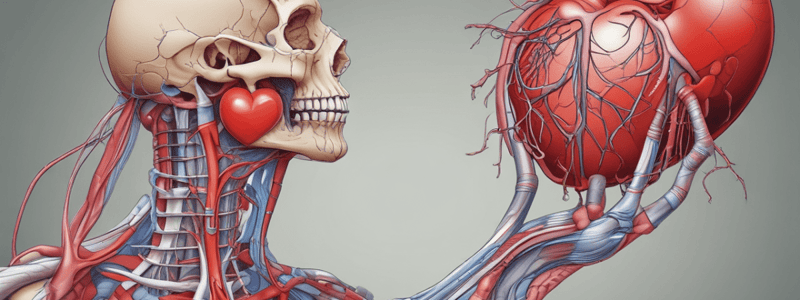Podcast
Questions and Answers
What are the two pumps of the heart?
What are the two pumps of the heart?
- Left and Right
- Atria and Ventricles
- Coronary and Pulmonary
- Pulmonic and Systemic (correct)
The coronary circulation refers to the arteries supplying blood to the heart muscle.
The coronary circulation refers to the arteries supplying blood to the heart muscle.
True (A)
What is the function of the cardiovascular system?
What is the function of the cardiovascular system?
The cardiovascular system pumps oxygenated blood to the tissues via the arteries and returns deoxygenated blood to the lungs via the veins.
The __________ carry blood away from the heart, usually containing oxygenated blood.
The __________ carry blood away from the heart, usually containing oxygenated blood.
Flashcards are hidden until you start studying
Study Notes
Cardiovascular System (CVS)
- The CVS is made up of the heart and vessels (veins and arteries)
- The heart has two sides, each acting as a pump:
- One side pumps to the body (systemic circulation), taking oxygen and nutrients to the tissues
- One side pumps to the lungs (pulmonary circulation), taking deoxygenated blood to the lungs
Heart Anatomy
- Located in the cranioventral thorax, between the 3rd and 6th/7th ribs, to the left side (behind the elbow)
- Surrounded by lungs and ribs
- Apex beat: where you can palpate (feel) the heart beat, best place to put a stethoscope to auscultate (hear) the heartbeat
Heart Chambers
- Four heart chambers: 2 atria (upper) and 2 ventricles (lower)
- Valves separate the atria from the ventricles
- Muscular walls enable coordinated contractions of cardiac muscle to pump blood
- Atria:
- Two smaller chambers at the base of the heart
- Receive blood from the body/lungs when relaxed
- Pump blood into the ventricles when contracted
- Ventricles:
- Two large chambers at the apex of the heart
- Receive blood from the atria when relaxed
- Pump blood out of the heart (to body/lungs) when contracted
Cardiac Valves
- Function: prevent backflow of blood during ventricular contraction and relaxation
- Ensure one-way flow of blood through the heart
- Made up of "leaflets" or "cusps"
- Two types of valves:
- Atrioventricular (AV) valves: between atria and ventricles
- Semi-lunar valves: in the arteries leaving the heart (pulmonary artery and aorta)
Blood Vessels
- Arteries: always carry blood away from the heart, usually carry oxygenated blood
- Veins: always carry blood towards the heart, usually contain deoxygenated blood
- Exceptions: pulmonary arteries and veins, which are the opposite of the usual oxygenation rule
Coronary Circulation
- The heart muscle itself receives oxygen and nutrients through the coronary arteries
- Coronary arteries originate from the base of the aorta and supply oxygenated blood to the heart muscle
- Coronary veins drain deoxygenated blood from the heart muscle back into the right atrium
Structure of the Heart Wall
- Layers of the heart:
- Pericardium: outer connective tissue layers
- Myocardium: middle, muscular layer (cardiac muscle)
- Endocardium: inner-most epithelial lining
Blood Flow through the Heart
- The heart acts as a pump to supply blood to the body
- Two pumps: systemic (left side) and pulmonary (right side)
- Systemic circulation: takes oxygenated blood from the lungs to the body for cellular respiration, and returns depleted blood to the heart
- Pulmonary circulation: takes deoxygenated blood from the body to the lungs, where it releases CO2 and picks up more O2
Studying That Suits You
Use AI to generate personalized quizzes and flashcards to suit your learning preferences.




